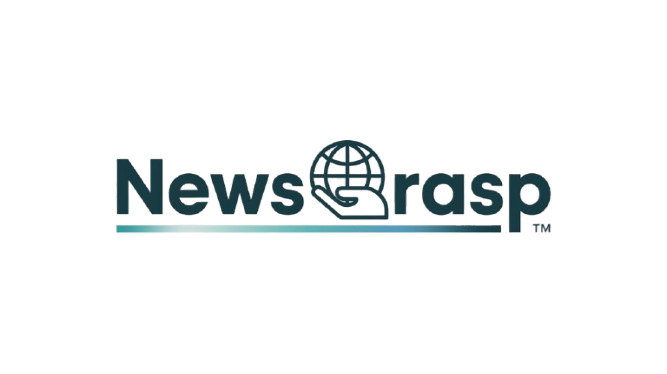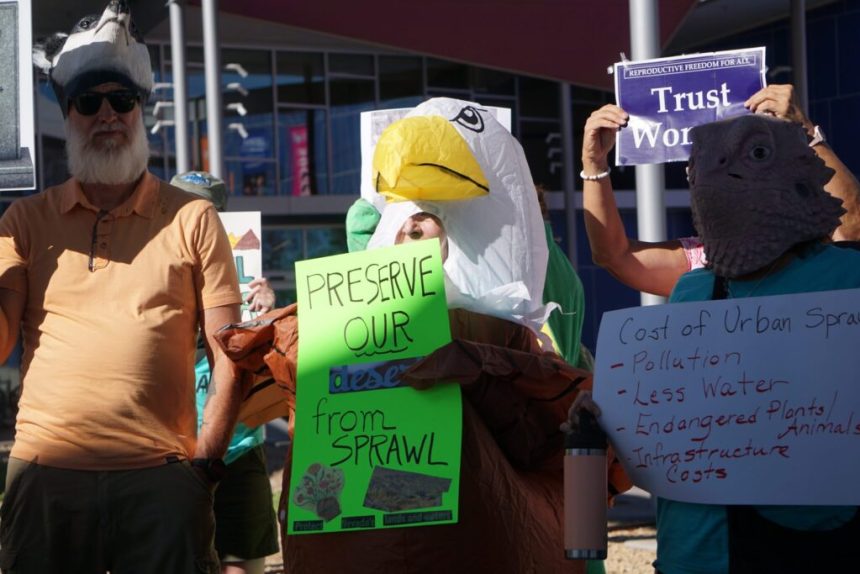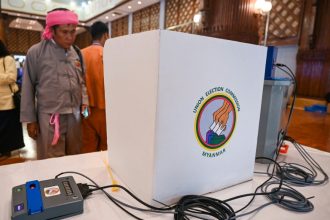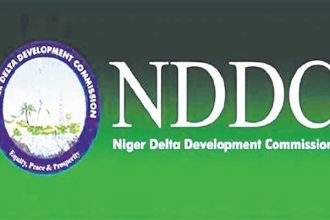(Photo by Jeniffer Solis/Nevada Current)
A proposed airport on a dry lakebed near the Nevada-California border is gaining traction as a solution to passenger demand – and raising questions about the potential impact on water, wildlife, and air quality.
Federal officials from the Federal Aviation Administration and the Bureau of Land Management held one of their first public meetings on the proposed Southern Nevada Supplemental Airport Wednesday– a project nearly three-decades in the making.
The airport would be one of the largest in the nation by land area, sprawling across 23,000 acres of public land in the Ivanpah Valley north of Primm.
Nearly a hundred people attended the meeting to provide public comments on the proposed airport – input that will help guide the federal government as they work through the environmental review process.
That review will likely center on the airport’s potential impact on two endangered species who call the area home: the desert tortoise and the white-margined penstemon, a small pink bell-shaped flower.
Proposed Southern Nevada Supplemental Airport. (Image courtesy of Federal Aviation Administration)
Early maps of the project show that desert tortoises will likely need to be relocated to accommodate the construction of the airport. However, recent studies have suggested that relocating desert tortoises can be detrimental to their survival.
One long-term study by the U.S. Geological Survey found that in the first three years of relocating 158 desert tortoises less than 10 miles from their habitat about 50% died, mostly due to predators.
The airport would also encroach on one of the sole known populations of the white-margined penstemon. A 2021 study commissioned by the U.S. Fish and Wildlife Service found a 50% chance of extinction for the wildflower in the next 50 years due to climate change and habitat destruction.
The Center for Biological Diversity and the Sierra Club Toiyabe Chapter held a press conference outside the meeting to speak on the airport’s potential impact on desert habitat and wildlife.
“If we destroy our desert for sprawl, we will end up harming our ecosystems, harming our air quality, diminishing our water supplies, and affecting people here in Las Vegas very substantially,” said Patrick Donnelly, the Great Basin director for the Center for Biological Diversity.
Critics of the multi-billion dollar project said the airport was a sign of reckless sprawl in Southern Nevada, a region experiencing severe long-term drought.
State officials have suggested the new airport could lead to further development. In 2023, state lawmakers unanimously approved Senate Bill 19 which would allow Clark County to put aside at least 5,000 acres for a new commercial and residential development in the vicinity of the new airport.
“We cannot afford to sprawl all the way down to Jean. We cannot afford the wildlife impacts or the water impacts or the air quality impacts from adding a second gigantic commercial airport,” said Vinny Spotleson, the president of the Sierra Club Toiyabe Chapter.
Several locals who spoke at the meeting questioned the need for a second airport, noting the development of high-speed rail between Nevada and California, and the presence of several other airports in southern Nevada that could be expanded to meet demand.
James Chrisley, the senior director for the Clark County Department of Aviation, said the Harry Reid International Airport will not be able to keep up with projected demand for air travel without the Southern Nevada Supplemental Airport.
According to estimates by the agency, the Harry Reid International Airport will reach its full capacity of 63 million to 65 million passengers annually by 2030. The airport would accommodate both passenger and cargo flights.
Decades-old decisions have also left the county with limited options when it comes to the location of an additional airport.
“We’re landlocked,” Chrisley said.
The Harry Reid Airport was initially built in 1942 outside the city of Las Vegas, in a relatively undeveloped area. However, the rapid growth of the Las Vegas metropolitan area over subsequent decades led to the city’s suburbs surrounding the airport, effectively landlocking it.
The Clark County Department of Aviation has evaluated several locations and looked into potentially modifying smaller airports to meet their needs, but concluded Ivanpah Valley was the only feasible option.
More than a dozen sites were evaluated by 2005 as potential locations for the airport before being whittled down to four: Apex, Eldorado Valley, Moapa Reservation, and Ivanpah Valley.
Nellis Air Force Base, Moapa Reservation, and Apex were eventually eliminated due to airspace constraints. Between Eldorado Valley and Ivanpah Valley, the latter won out.
“We’ve revalidated that study recently and continue to look at it just to make sure this is truly the only feasible site,” Chrisley said.
Plans for the airport were first initiated in 2000 when the Ivanpah Valley Airport Public Lands Act, championed by U.S. Senator Harry Reid and signed into law by President Bill Clinton, transferred about 6,000 acres of public land to Clark County for a new airport.
The Clark County Department of Aviation submitted their first draft by 2006, but local economic conditions following the Great Recession and other local budgetary constraints stalled the project for decades. In 2010 the Clark County Department of Aviation asked the federal government to suspend any work on the environmental review.
Chrisley said things changed this year after the Harry Reid International Airport recorded 58.4 million passengers last year, a 1.39% increase over 2023’s previous high.
“We’ve been planning this for 25 years, and I personally have been on this for the last almost 10 years. It’s time. The Valley continues to grow and we need to support the innovation of this community,” Chrisley said.
Preliminary plans show the airport would include a central terminal, two runways, a taxiway system, and an air traffic control tower. The plan would also require an expansion of the Interstate-15 and a new dedicated interchange.
Nevada Current is part of States Newsroom, a nonprofit news network supported by grants and a coalition of donors as a 501c(3) public charity. Nevada Current maintains editorial independence. Contact Editor Hugh Jackson for questions: info@nevadacurrent.com.









